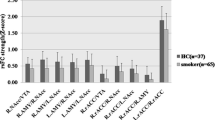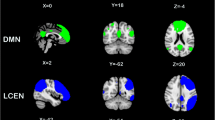Abstract
Previous studies have found that the striatum and the cerebellum played important roles in nicotine dependence, respectively. In heavy smokers, however, the effect of resting-state functional connectivity of cerebellum-striatum circuits in nicotine dependence remained unknown. This study aimed to explore the role of the circuit between the striatum and the cerebellum in addiction in heavy smokers using structural and functional magnetic resonance imaging. The grey matter volume differences and the resting-state functional connectivity differences in cerebellum-striatum circuits were investigated between 23 heavy smokers and 23 healthy controls. The cigarette dependence in heavy smokers and healthy controls were evaluated by using Fagerström Test. Then, we applied mediation analysis to test whether the resting-state functional connectivity between the striatum and the cerebellum mediates the relationship between the striatum morphometry and the nicotine dependence in heavy smokers. Compared with healthy controls, the heavy smokers’ grey matter volumes decreased significantly in the cerebrum (bilateral), and increased significantly in the caudate (bilateral). Seed-based resting-state functional connectivity analysis showed significantly higher resting-state functional connectivity among the bilateral caudate, the left cerebellum, and the right middle temporal gyrus in heavy smokers. The cerebellum-striatum resting-state functional connectivity fully mediated the relationship between the striatum morphometry and the nicotine dependence in heavy smokers. Heavy smokers showed abnormal interactions and functional connectivity between the striatum and the cerebellum, which were associated with the striatum morphometry and nicotine dependence. Such findings could provide new insights into the neural correlates of nicotine dependence in heavy smokers.



Similar content being viewed by others
Availability of data and material
The data for this study are not publicly available because Zhongnan Hospital of Wuhan University, the centre from which the data were collected, does not agree to make the data publicly accessible. Further inquiry about data sharing maybe directed to Prof. Bingsheng Huang, huangb@szu.edu.cn.
Code availability
Not applicable.
References
Barrett, S. P., Boileau, I., Okker, J., Pihl, R. O., & Dagher, A. (2004). The hedonic response to cigarette smoking is proportional to dopamine release in the human striatum as measured by positron emission tomography and [11C]raclopride. Synapse (New York, N.Y.), 54(2), 65–71. https://doi.org/10.1002/syn.20066
Brody, A. L., Mandelkern, M. A., Jarvik, M. E., Lee, G. S., Smith, E. C., Huang, J. C., Bota, R. G., Bartzokis, G., & London, E. D. (2004). Differences between smokers and nonsmokers in regional gray matter volumes and densities. Biological Psychiatry, 55(1), 77–84. https://doi.org/10.1016/s0006-3223(03)00610-3
Courtney, R. (2015). The Health Consequences of Smoking-50 Years of Progress: A Report of the Surgeon General, 2014. Drug and Alcohol Review, 34(6), 694–695. https://doi.org/10.1111/dar.12309
Dani, J. A., & Bertrand, D. (2007). Nicotinic acetylcholine receptors and nicotinic cholinergic mechanisms of the central nervous system. Annual Review of Pharmacology and Toxicology, 47, 699–729. https://doi.org/10.1146/annurev.pharmtox.47.120505.105214
Doya, K. (2000). Complementary roles of basal ganglia and cerebellum in learning and motor control. Current Opinion in Neurobiology, 10(6), 732–739. https://doi.org/10.1016/s0959-4388(00)00153-7
Froeliger, B., McConnell, P. A., Stankeviciute, N., McClure, E. A., Kalivas, P. W., & Gray, K. M. (2015). The effects of N-Acetylcysteine on frontostriatal resting-state functional connectivity, withdrawal symptoms and smoking abstinence: A double-blind, placebo-controlled fMRI pilot study. Drug and Alcohol Dependence, 156, 234–242. https://doi.org/10.1016/j.drugalcdep.2015.09.021
Gallezot, J. D., Kloczynski, T., Weinzimmer, D., Labaree, D., Zheng, M. Q., Lim, K., Rabiner, E. A., Ridler, K., Pittman, B., Huang, Y., Carson, R. E., Morris, E. D., & Cosgrove, K. P. (2014). Imaging nicotine- and amphetamine-induced dopamine release in rhesus monkeys with [(11)C]PHNO vs [(11)C]raclopride PET. Neuropsychopharmacology: Official Publication of the American College of Neuropsychopharmacology, 39(4), 866–874. https://doi.org/10.1038/npp.2013.286
Gallinat, J., Meisenzahl, E., Jacobsen, L. K., Kalus, P., Bierbrauer, J., Kienast, T., Witthaus, H., Leopold, K., Seifert, F., Schubert, F., & Staedtgen, M. (2006). Smoking and structural brain deficits: A volumetric MR investigation. The European Journal of Neuroscience, 24(6), 1744–1750. https://doi.org/10.1111/j.1460-9568.2006.05050.x
Godtfredsen, N. S., Holst, C., Prescott, E., Vestbo, J., & Osler, M. (2002). Smoking reduction, smoking cessation, and mortality: A 16-year follow-up of 19,732 men and women from The Copenhagen Centre for Prospective Population Studies. American Journal of Epidemiology, 156(11), 994–1001. https://doi.org/10.1093/aje/kwf150
Heatherton, T. F., Kozlowski, L. T., Frecker, R. C., & Fagerstrom, K. O. (1991). The Fagerstrom Test for Nicotine Dependence: A revision of the Fagerstrom Tolerance Questionnaire. British Journal of Addiction, 86(9), 1119–1127. https://doi.org/10.1111/j.1360-0443.1991.tb01879.x
Herman, A. I., DeVito, E. E., Jensen, K. P., & Sofuoglu, M. (2014). Pharmacogenetics of nicotine addiction: Role of dopamine. Pharmacogenomics, 15(2), 221–234. https://doi.org/10.2217/pgs.13.246
Hoshi, E., Tremblay, L., Feger, J., Carras, P. L., & Strick, P. L. (2005). The cerebellum communicates with the basal ganglia. Nature Neuroscience, 8(11), 1491–1493. https://doi.org/10.1038/nn1544
Hu, S. S., Neff, L., Agaku, I. T., Cox, S., Day, H. R., Holder-Hayes, E., & King, B. A. (2016). Tobacco Product Use Among Adults - United States, 2013–2014. (MMWR) Morbidity and Mortality Weekly Report, 65(27), 685–691. https://doi.org/10.15585/mmwr.mm6527a1
Jasinska, A. J., Stein, E. A., Kaiser, J., Naumer, M. J., & Yalachkov, Y. (2014). Factors modulating neural reactivity to drug cues in addiction: A survey of human neuroimaging studies. Neuroscience and Biobehavioral Reviews, 38, 1–16. https://doi.org/10.1016/j.neubiorev.2013.10.013
Kober, H., Mende-Siedlecki, P., Kross, E. F., Weber, J., Mischel, W., Hart, C. L., & Ochsner, K. N. (2010). Prefrontal-striatal pathway underlies cognitive regulation of craving. Proc Natl Acad Sci U S A, 107(33), 14811–14816. https://doi.org/10.1073/pnas.1007779107
Koob, G. F., & Volkow, N. D. (2010). Neurocircuitry of addiction. Neuropsychopharmacology: Official Publication of the American College of Neuropsychopharmacology, 35(1), 217–238. https://doi.org/10.1038/npp.2009.110
Kühn, S., Romanowski, A., Schilling, C., Mobascher, A., Warbrick, T., Winterer, G., & Gallinat, J. (2012). Brain grey matter deficits in smokers: Focus on the cerebellum. Brain Structure & Function, 217(2), 517–522. https://doi.org/10.1007/s00429-011-0346-5
Li, Y., Yuan, K., Cai, C., Feng, D., Yin, J., Bi, Y., Shi, S., Yu, D., Jin, C., von Deneen, K. M., Qin, W., & Tian, J. (2015). Reduced frontal cortical thickness and increased caudate volume within fronto-striatal circuits in young adult smokers. Drug and Alcohol Dependence, 151, 211–219. https://doi.org/10.1016/j.drugalcdep.2015.03.023
Mansvelder, H. D., Mertz, M., & Role, L. W. (2009). Nicotinic modulation of synaptic transmission and plasticity in cortico-limbic circuits. Seminars in Cell & Developmental Biology, 20(4), 432–440. https://doi.org/10.1016/j.semcdb.2009.01.007
Mechelli, A., Price, C. J., Friston, K. J., & Ashburner, J. (2005). Voxel-based morphometry of the human brain: Methods and applications. Current Medical Imaging, 1(2), 105–113. https://doi.org/10.2174/1573405054038726
Miquel, M., Vazquez-Sanroman, D., Carbo-Gas, M., Gil-Miravet, I., Sanchis-Segura, C., Carulli, D., Manzo, J., & Coria-Avila, G. A. (2016). Have we been ignoring the elephant in the room? Seven arguments for considering the cerebellum as part of addiction circuitry. Neuroscience and Biobehavioral Reviews, 60, 1–11. https://doi.org/10.1016/j.neubiorev.2015.11.005
Moulton, E. A., Elman, I., Becerra, L. R., Goldstein, R. Z., & Borsook, D. (2014). The cerebellum and addiction: Insights gained from neuroimaging research. Addiction Biology, 19(3), 317–331. https://doi.org/10.1111/adb.12101
Shen, Z., Huang, P., Wang, C., Qian, W., Yang, Y., & Zhang, M. (2018). Cerebellar Gray Matter Reductions Associate With Decreased Functional Connectivity in Nicotine-Dependent Individuals. Nicotine & Tobacco Research, 20(4), 440–447. https://doi.org/10.1093/ntr/ntx168
Shi, Y. Y., Zhang, Y., Cheng, J. L., Zhu, C. D., Xu, K., & Wang, W. J. (2019). Study on the mechanism of brain damage based on structural covariant network to evaluate the brain structure of nicotine addicts. Zhonghua Yi Xue Za Zhi, 99(9), 669–674. https://doi.org/10.3760/cma.j.issn.0376-2491.2019.09.007
Sutherland, M. T., Riedel, M. C., Flannery, J. S., Yanes, J. A., Fox, P. T., Stein, E. A., & Laird, A. R. (2016). Chronic cigarette smoking is linked with structural alterations in brain regions showing acute nicotinic drug-induced functional modulations. Behavioral and Brain Functions: BBF, 12(1), 16. https://doi.org/10.1186/s12993-016-0100-5
Swain, R. A., Kerr, A. L., & Thompson, R. F. (2011). The cerebellum: A neural system for the study of reinforcement learning. Frontiers in Behavioral Neuroscience, 5, 8. https://doi.org/10.3389/fnbeh.2011.00008
Thoma, P., Bellebaum, C., Koch, B., Schwarz, M., & Daum, I. (2008). The cerebellum is involved in reward-based reversal learning. Cerebellum (london, England), 7(3), 433–443. https://doi.org/10.1007/s12311-008-0046-8
Tsukada, H., Miyasato, K., Harada, N., Nishiyama, S., Fukumoto, D., & Kakiuchi, T. (2005). Nicotine modulates dopamine synthesis rate as determined by L-[beta-11C]DOPA: PET studies compared with [11C]raclopride binding in the conscious monkey brain. Synapse (New York, N.Y.), 57(2), 120–122. https://doi.org/10.1002/syn.20157
Van Schayck, O. C. P., Williams, S., Barchilon, V., Baxter, N., Jawad, M., Katsaounou, P. A., Kirenga, B. J., Panaitescu, C., Tsiligianni, I. G., Zwar, N., Ostrem, A. (2017). Treating tobacco dependence: guidance for primary care on life-saving interventions. Position statement of the IPCRG.npj. Primary Care Respiratory Medicine, 27,(1). https://doi.org/10.1038/s41533-017-0039-5
Wetherill, R. R., Fang, Z., Jagannathan, K., Childress, A. R., Rao, H., & Franklin, T. R. (2015). Cannabis, cigarettes, and their co-occurring use: Disentangling differences in default mode network functional connectivity. Drug and Alcohol Dependence, 153, 116–123. https://doi.org/10.1016/j.drugalcdep.2015.05.046
Weywadt, C. R., Kiehl, K. A., & Claus, E. D. (2017). Neural correlates of response inhibition in current and former smokers. Behavioural Brain Research, 319, 207–218. https://doi.org/10.1016/j.bbr.2016.11.030
Wilson, S. J., Creswell, K. G., Sayette, M. A., & Fiez, J. A. (2013). Ambivalence about smoking and cue-elicited neural activity in quitting-motivated smokers faced with an opportunity to smoke. Addictive Behaviors, 38(2), 1541–1549. https://doi.org/10.1016/j.addbeh.2012.03.020
Wooltorton, J. R. A., Pidoplichko, V. I., Broide, R. S., & Dani, J. A. (2003). Differential desensitization and distribution of nicotinic acetylcholine receptor subtypes in midbrain dopamine areas. Journal of Neuroscience, 23(8), 3176–3185.
Wu, G., Yang, S., Zhu, L., & Lin, F. (2015). Altered spontaneous brain activity in heavy smokers revealed by regional homogeneity. Psychopharmacology (berl), 232(14), 2481–2489. https://doi.org/10.1007/s00213-015-3881-6
Yan, C.-G., Craddock, R. C., He, Y., & Milham, M. (2013). Addressing head motion dependencies for small-world topologies in functional connectomics. Frontiers in Human Neuroscience, 7, 910.
Yan, C.-G., Wang, X.-D., Zuo, X.-N., & Zang, Y.-F. (2016). DPABI: Data Processing & Analysis for (Resting-State) Brain Imaging. Neuroinformatics, 14(3), 339–351. https://doi.org/10.1007/s12021-016-9299-4
Yuan, K., Yu, D., Bi, Y., Li, Y., Guan, Y., Liu, J., Zhang, Y., Qin, W., Lu, X., & Tian, J. (2016). The implication of frontostriatal circuits in young smokers: A resting-state study. Human Brain Mapping, 37(6), 2013–2026. https://doi.org/10.1002/hbm.23153
Acknowledgements
The authors want to thank the Zhongnan Hospital of Wuhan University, participants who took part in the study and data collection.
Funding
This study was supported by the National Natural Science Foundation of China (No. 2016YFC1304702), National Natural Science Foundation of China (No. 61973220), Shenzhen University Presidential Fund (No. 85706–0000040544), Shenzhen Science and Technology Project (No. JCYJ20190808175413552), Guangdong Basic and Applied Basic Research Foundation (No.2020A1515010571), Shenzhen-Hong Kong Institute of Brain Science-Shenzhen Fundamental Research Institutions (No.2019SHIBS0003), Guangdong Key Basic Research Grant (No.2018B030332001), and Guangdong Pearl River Talents Plan (No.2016ZT06S220).
Author information
Authors and Affiliations
Contributions
Author contributions included conception and study design (Z.C., P.W., G.W., J.Z. and B.H), data collection oracquisition(Z.C., P.W., G.W., J.Z. and B.H.), statistical analysis (Z.C., S.W., J.T., J.Z., G.W. and B.S), interpretation of results (Z.C., P.W., J.Z., G.W. and B.S), drafting the manuscript work or revising it critically for important intellectual content(Z.C., P.W., J.Z., G.W. and B.S) and approval of final version to be published and agreement to be accountable for the integrity and accuracy of all aspects of the work(All authors).
Corresponding authors
Ethics declarations
Ethics approval
Informed consent approved by the Medical Ethics Committee of Zhongnan Hospital of Wuhan University was obtained from all participants.
Consent to participate
Not applicable.
Consent for publication
Not applicable.
Conflict of Interest
The authors report no conflict of interest.
Additional information
Publisher's nte
Springer Nature remains neutral with regard to jurisdictional claims in published maps and institutional affiliations.
Zongyou Cai and Panying Wang are equal contributors, and co-first authors.
Rights and permissions
About this article
Cite this article
Cai, Z., Wang, P., Liu, B. et al. To explore the mechanism of tobacco addiction using structural and functional MRI: a preliminary study of the role of the cerebellum-striatum circuit. Brain Imaging and Behavior 16, 834–842 (2022). https://doi.org/10.1007/s11682-021-00546-0
Accepted:
Published:
Issue Date:
DOI: https://doi.org/10.1007/s11682-021-00546-0




